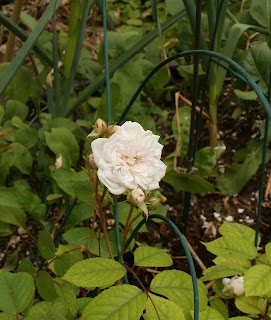 |
| Bleu Magenta |
Last spring my gardening guru mentioned that he was trying his hand with
roses. (I think of him as Quickbeam, Tolkien’s hasty Ent, because he is tall
with a booming voice and has been known to sing to trees.) When he tries
something, he plunges in as deep as he can go. He ordered 50 or 60 own-root
roses, especially those that were reputed to do well in shade. He put them all in containers, because his town does not allow front-yard gardens. The town even puts a limit on pots in front of houses, so the
shade-tolerant roses went to live in his back yard. If they did well under his
trees, he told me, he might want to transplant some of them to clearings in my
woods.
Late in August, after I had forgotten the conversation completely, he called: “When would be a good time for me to come plant roses?” The next
weekend, he pulled into my driveway with six full-sized rose bushes and two
minis. Bales of organic fertilizer filled the back of his van. His full-time client gave me a resigned look from the passenger's seat and pointed to a rose bush when I brought him lemonade.
Quckbeam started digging holes, and I started carrying water. As the second
rose went into the ground, another friend arrived — Rowan, as tall as Quickbeam
and 20 years younger. We handed him a shovel. They made short work of roots and
rocks that would have taken me weeks to clear. As they dug, Quickbeam recited
the pedigree of each rose and instructed me on care and watering.
 |
| Bubble Bath |
Bubble Bath, a Zone 6 hybrid musk rose, went in nearest the house, where
I might remember to give it winter shelter. Three bushes went into the clearing
under the power line — Country Dancer, a Buck rose, and two Albas, Celestial and Semi Plena, the white rose of York. Greenmantle, a
sweet briar, and Bleu Magenta, a rambler, have the sunniest places beside the
road, where they can climb into the trees. I found spots on the
patio for the potted minis, Cinderella and Sweet Fairy. When everybody was settled, I dragged the guys inside for iced tea and made Quickbeam repeat the
details while I took notes.
September can be hot and dry here. Drought is almost guaranteed if you
have six new roses to water. Quickbeam is the consummate gardener, attending to
the particular needs of each plant daily. I work more by benevolent neglect and random watering. Still, after such a noble gift, I did my best to
keep the roses hydrated. In October the deer began feeding up for mating
season. I noticed missing leaves on the roses, then missing canes. Celestial
was eventually mowed to the ground. Quickbeam did a little more research and
told me that, yes, deer do eat rose bushes in spite of thorns.
 |
| Greenmantle |
I put tomato cages around the roses. Wire frames can’t really prevent
grazing, but deer don’t seem to like bumping their noses while they eat. The
roses began to leaf out in March, even Celestial. By April Greenmantle grew as
high as my heart.
Yesterday, the first blooms opened on Bubble Bath and Greenmantle. Bleu
Magenta is budding, and the three in the shadier spot are fully leafed out. The
mini roses came through the winter inside. Sweet Fairy bloomed for us in
December.
Quickbeam has started more roses this year, overflowing his yard to the lawn of the group home where he teaches. Once his new rose fosterlings are
large enough, he will find adoptive parents for them. He works with the deepest
magic, nurturing and sharing the pure joy of being. His spell comes from
legend: Johnny Appleseed roaming the wilderness seeding it with beauty. Ecstacy
transcends struggle. Exuberance can transform surviving into flourishing.




